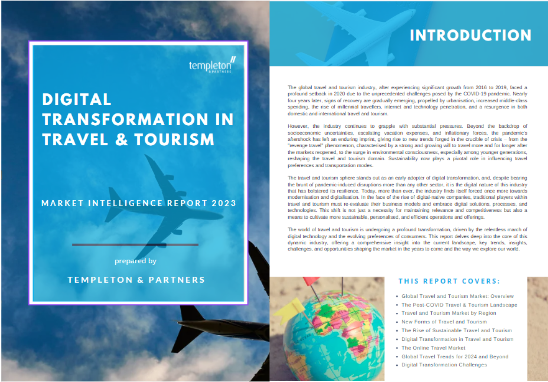The global travel and tourism industry, after experiencing significant growth from 2016 to 2019, faced a profound setback in 2020 due to the unprecedented challenges posed by the COVID-19 pandemic. Nearly four years later, signs of recovery are gradually emerging, propelled by urbanisation, increased middle-class spending, the rise of millennial travellers, internet and technology penetration, and a resurgence in both domestic and international travel and tourism.

However, the industry continues to grapple with substantial pressures. Beyond the backdrop of socioeconomic uncertainties, escalating vacation expenses, and inflationary forces, the pandemic's aftershock has left an enduring imprint, giving rise to new trends forged in the crucible of crisis – from the "revenge travel" phenomenon, characterised by a strong and growing will to travel more and for longer after the markets reopened, to the surge in environmental consciousness, especially among younger generations, reshaping the travel and tourism domain. Sustainability now plays a pivotal role in influencing travel preferences and transportation modes.
The travel and tourism sphere stands out as an early adopter of digital transformation, and, despite bearing the brunt of pandemic-induced disruptions more than any other sector, it is the digital nature of this industry that has bolstered its resilience. Today, more than ever, the industry finds itself forced once more towards modernisation and digitalisation. In the face of the rise of digital-native companies, traditional players within travel and tourism must re-evaluate their business models and embrace digital solutions, processes, and technologies. This shift is not just a necessity for maintaining relevance and competitiveness but also a means to cultivate more sustainable, personalised, and efficient operations and offerings.
The world of travel and tourism is undergoing a profound transformation, driven by the relentless march of digital technology and the evolving preferences of consumers. With this report, Templeton and Partners provide the latest UK, European and global travel and tourism insights into the current landscape of Travel and Tourism. Specifically, this report covers the following topics:
- Global Travel and Tourism Market: Overview
- The Post-COVID Travel & Tourism Landscape
- Travel and Tourism Market by Region
- New Forms of Travel and Tourism
- The Rise of Sustainable Travel and Tourism
- Digital Transformation in Travel and Tourism
- The Online Travel Market
- Global Travel Trends for 2024 and Beyond
- Digital Transformation Challenges
The most recent research and projections from leading publications and institutions, such as WTTC, Oxford Economics, IATA, ACEA, European Travel Commission, McKinsey, UNWTO, Reuters, and Harvard Business Review, reveal expert insights into the current trends, challenges, and opportunities that will shape the Travel and Tourism market in the years to come.
Download our free Digital Transformation in Automotive Market Report 2023

Global Market Overview
- Digital Transformation in the Travel and Tourism Industry – The travel industry is at the forefront of digital innovation and continues to be transformed by new technologies in virtually every aspect of its operations. Digitisation processes in the travel, tourism, and aviation sectors will be worth up to $305 billion between 2016 and 2025 (World Economic Forum’s Digital Transformation Initiative).
- Industry Resilience – Against all odds, international tourism rebounded in 2022. visitor numbers to Europe and the Middle East climbed to around 80% of 2019 levels, and the Americas recovered about 65% of pre-pandemic visitors (McKinsey).
- Market Growth – The Travel and Tourism market is expected to experience substantial growth, with projected revenues reaching an impressive $854.70 billion in 2023. This growth is further bolstered by an anticipated compound annual growth rate (CAGR) of 4.42% between 2023 and 2027, propelling the market's size to an estimated $1,016.00 billion by 2027 (WTTC).
- Online Travel Market Size – The market size of the online travel industry worldwide was expected to increase in 2023 over the previous year. As estimated, the global online market size totalled approximately $475 billion in 2022. This figure was forecast to surpass $521 billion by the end of 2023 and rise to over one trillion dollars by 2030 (GlobalData).
The Post-COVID Travel and Tourism Landscape
- Towards Full Recovery – The global travel and tourism sector is on track for a full recovery from the COVID-19 impact by 2024. In 2023, it's expected to reach a GDP contribution of $9.5 trillion, just 5% below 2019 levels. Research indicates that 34 countries have already surpassed their 2019 performance. By year-end, nearly half of the 185 countries worldwide will have either fully recovered or be within 95% of pre-pandemic levels (Investment Monitor).
- Geopolitical Challenges – The Ukraine conflict and ongoing travel restrictions, especially in China, significantly impacted global recovery. However, the reopening of China's borders in January is poised to propel the sector to pre-pandemic levels next year (WTTC & Oxford Economics).
- Reviving Spending – The global business travel industry has rebounded at a more accelerated rate than expected just a year ago and is now expected to surpass its pre-pandemic spending level of $1.4 trillion in 2024 − and grow to nearly $1.8 trillion by 2027 (BTI - GBTA Business Travel Outlook).
- Resilient Sector – Despite economic and geopolitical hurdles, the sector's recovery soared by 22% in 2022, reaching $7.7 trillion and contributing 7.6% to the global economy, the highest since before COVID-19. However, global GDP remained 22.9% below its 2019 peak (World Economic Outlook, 2023).

New Forms of Travel and Tourism
- Digital Tourism – Post-pandemic, there has been a rise in digital tourism, defined as "utilising digital technologies to enrich tourists' and visitors' experiences." Mobile apps are an example, helping travellers in navigating destinations. While Google Maps leads the way, numerous location-specific apps help locate attractions, restaurants, and businesses. Additionally, social media plays a pivotal role in sharing travel experiences (Digital Adoption).
- Business Travel – Global business travellers currently estimate their average spending per trip at $1,018 per person. Among these expenses, accommodation averages $391, food and beverage amounts to $189, air travel is around $182, ground transportation stands at $136, and miscellaneous expenses add up to $120, completing the total expenditure.
- Bleisure Travel – Approximately 62% of business travellers now engage more often in "bleisure" travel, combining business with personal trips, compared to their 2019 habits. Of these, 42% extend their business trips with extra leisure days. Notably, 79% of these travellers opt for the same accommodation for both the business and holiday aspects of their journey (GBTA).
The Rise of Sustainable Travel and Tourism
- Sustainability Is the Standard – 83% of global travellers think sustainable travel is vital, with 61% saying the pandemic has made them want to travel more sustainably in the future. The ‘new traveller’ is greener and no longer tolerates paying for travel experiences that aren’t environmentally friendly. That includes reducing their carbon footprint – 69% of travellers want to reduce the carbon footprint of their vacation (com).
- The Importance of Sustainable Tourism – 83% of travellers worldwide believed sustainable travel is important, and 81% of them intended to stay at least once in an eco-friendly or green accommodation when looking at the year ahead. Such eco-friendly or green accommodations have helped companies like Airbnb become more popular (Statista).
- The Sustainable Tourism Market – The market is estimated to grow at a CAGR of 9.54% between 2022 and 2027. The size of the market is forecast to increase by $336 billion. This growth depends on several factors, including the large tourism companies implementing sustainable tourism practices, the shifting preference toward local and authentic experiences, and the increasing number of travellers opting for new types of tourism (Technavio).
Download the Free Market Intelligence Report to discover more on:
- Industry Challenges – When will the industry fully recover from the pandemic shock, and how will it keep up with the current market trends, pressures and ongoing technological changes?
- Key Trends – Which are the most important travel and tourism trends, and how are they transforming the industry?
- Digital Transformation – How automation and digitisation are impacting the businesses in the sector, and how can they keep up with the emerging forms of travel and tourism?
- Drivers for Digital Transformation – Which are the leading drivers of digital transformation in the travel and tourism sector?
- Tourism 4.0 – How is Industry 4.0 adding value to the travel and tourism market, and how businesses in the sector can benefit from technologies like automation, virtual reality, big data and AI?





